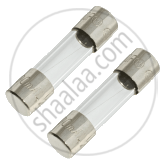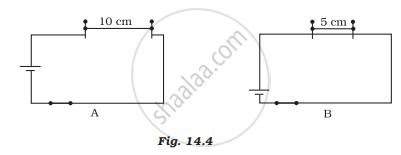Advertisements
Advertisements
प्रश्न
Solve the following example.
Two tungsten bulbs of wattage 100 W and 60 W power work on 220 V potential difference. If they are connected in parallel, how much current will flow in the main conductor?
उत्तर १
Power of first bulb, P1 = 100 W
Power of second bulb, P2 = 60 W
Now,
Resistance of first bulb, `R_1 = (V^2)/(P_1)=(220xx220)/100 = 484 Ω`
When the bulbs are connected in parallel, their equivalent resistance is
उत्तर २
Potential remains same in the resistors when they are connected in the parallel.
∴ Potential in both the bulbs will be same.
Now,
For First Tungsten Bulb,
Power = 100 W.
Potential = 220 V.
∵ Power = Potential × Current.
∴ Current = 100/220
⇒ Current = 0.45 A.
For second Tungsten bulbs,
Power = 60 W.
Potential = 220 V.
∴ Current = 60/220
= 0.27 A.
Now, Total current flowing = Current in 1st bulb + Current in 2nd bulb.
= 0.45 + 0.27
= 0.72 A.
Hence, the total current flowing in the main conductor is 0.72 A.
APPEARS IN
संबंधित प्रश्न
Why is the tungsten used almost exclusively for filament of electric lamps?
When current is switched ‘on’ in a room heater, it ______.
An electric room heater draws a current of 2.4 A from the 120 V supply line. What current will this room heater draw when connected to 240 V supply line?
Why is a series arrangement not used for connecting domestic electrical appliances in a circuit?
An electric iron of resistance 20 ohms draws a current of 5 amperes. Calculate the heat produced in 30 seconds.
The current passing through a room heater has been halved. What will happen to the heat produced by it?
Name the material which is used for making the filaments of an electric bulb.
The elements of electrical heating devices are usually made of:
(a) tungsten
(b) bronze
(c) nichrome
(d) argon
How does the wire in the filament of a light bulb behave differently to the other wires in the circuit when the current flows?
What property of the filament wire accounts for this difference?
Two exactly similar heating resistances are connected (i) in series, and (ii) in parallel, in two different circuits, one by one. If the same current is passed through both the combinations, is more heat obtained per minute when they are connected in series or when they are connected in parallel? Give reason for your answer.
An electric iron is connected to the mains power supply of 220 V. When the electric iron is adjusted at 'minimum heating' it consumes a power of 360 W but at 'maximum heating' it takes a power of 840 W. Calculate the current and resistance in each case.
Identify the figure and give its use.

Give scientific reason :
In the electric equipment producing heat e.g. iron, electric heater, boiler, toaster, etc., an alloy such as Nichrome is used, not pure metals.
Rewrite the following statement by selecting the correct option:
1 A = ____________ mA.
What is the heating effect of electric current?
Write two devices based on the heating effect of electric current.
How can overloading be avoided?
Define fuse.
Name some devices that run using heat effect of electric current
Heating effect of current is called ______
A current of 1 A is drawn by a filament of an electric bulb. Number of electrons passing through a cross-section of the filament in 16 seconds would be roughly:
Three incandescent bulbs of 100 W each are connected in series in an electric circuit. In another circuit another set of three bulbs of the same wattage are connected in parallel to the same source.
- Will the bulb in the two circuits glow with the same brightness? Justify your answer.
- Now let one bulb in both the circuits get fused. Will the rest of the bulbs continue to glow in each circuit? Give reason.
What is Joule’s heating effect? How can it be demonstrated experimentally? List its four applications in daily life.
When a switch is in the OFF position,
(i) circuit starting from the positive terminal of the cell stops at the switch.
(ii) circuit is open.
(iii) no current flows through it.
(iv) current flows after some time. Choose the combination of the correct answers from the following.
Can we use the same fuse in a geyser and a television set? Explain.
Name two electric devices for each where
(i) the heating effect of current is used and
(ii) the magnetic effect of current is used.
Paheli took a wire of length of 10 cm. Boojho took a wire of 5 cm of the same material and thickness. Both of them connected the wires as shown in the circuit given in Figure 14.4. The current flowing in both circuits is the same.
(i) Will the heat produced in both cases be equal? Explain
(ii) Will the heat produced be the same if the wires taken by them are of equal lengths but of different thicknesses? Explain.

An electric fuse has a body made of ceramic and two points for connecting the fuse wire.
What is an electric fuse made up of?
Explain the working of an electric fuse.
Copper wire offers very little ______ and does not get heated up quickly.
Match the following
| 1. | Bulb | a. | Conductor |
| 2. | Electroplating | b. |
Insulator |
| 3. | Pure water | c. | Heating effect of current |
| 4. | Salt solution | d. | Chemical effect of current |
Name a few appliances which work on the basis of the heating effect of current.
In the electric equipment producing heat like iron, electric heater, boiler, toaster etc., an alloy such as nichrome is used, not pure metals.
When a current I flows through a wire of resistance R for time t then the electrical energy produced is given by ______.
An electric iron of resistance 20 Ω draws a current of 5 A. The heat developed in the iron in 30 seconds is ______.
